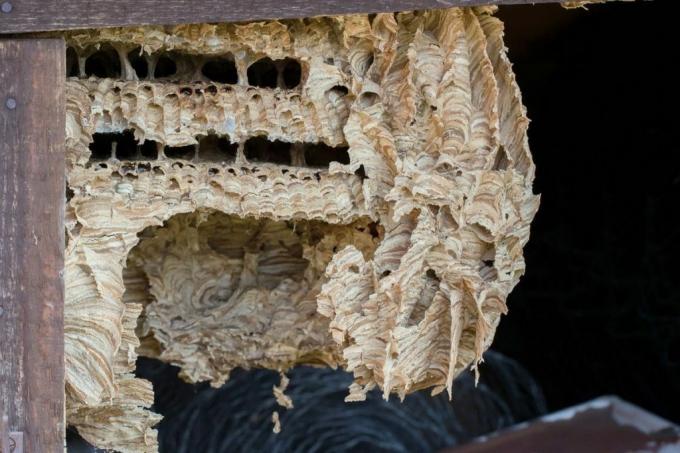
table of contents
- From style to size
- The nest during the year
- Location differences
- frequently asked Questions
Anyone who finds wasps or even a nest in the garden or around the house can easily panic. Because countless animals cavort in and around the dwelling. But how many wasps actually live in a nest?
In a nutshell
- the number of animals per wasp colony differ greatly from species to species
- Socially parasitic wasp species do not build nests at all, but let other species raise their brood in their nests
- Location, food supply and season have a direct influence on the nest size and number of animals
From style to size
Each wasp species has its own characteristics in terms of development and colony size. Of course, this also has a direct impact on how many wasps are in the nest. You can see this with the naked eye from the dimensions of the house built, but you can also see it from known numbers. These well-known wasp species develop colonies of the following sizes:
Genus Hornets (Vespa)
- hornet (Vespa crabro): less than 200 animals on average

Genus short-headed wasps (Vespula)
- Common wasp (Vespula vulgaris): approx. 3,000 to 4,000 animals
- German wasp (Vespula germanica): approx. 3,000 to 4,000 animals
- Red wasp (Vespula rufa): approx. 150 to 350 animals
- Austrian cuckoo wasp (Vespula austriaca): no nest building, but socially parasitic raising of the brood in nests of the red wasp
Genus long-headed wasps (Dolichovespula)

- Medium wasp (Dolichovespula media): approx. 900 to 1,700 animals
- Wood wasp (Dolichovespula sylvestris): approx. 800 animals
- Saxon wasp (Dolichovespula saxonica): approx. 1,000 animals
- False cuckoo wasp (Dolichovespula adulterina): no own nest building, but socially parasitic nesting in nests of the Saxon wasp
- Forest cuckoo wasp (Dolichovespula omissa): Social parasite of the wood wasp, therefore only very small numbers of individuals in the foreign nest are used
- Norwegian wasp (Dolichovespula norwegica): an average of 200 to 300 animals
Note: Invasive species, such as the North American hornet, are currently found again and again. However, they are still so rare that it is hardly possible to draw conclusions about their behavior and attainable nest sizes in the new habitat.
The nest during the year
Regardless of the exact species, the development of the colonies in wasps is always the same: In spring, the overwintered young queen starts building nests and laying her first eggs on her own. From this moment on, the colony grows steadily until it reaches its maximum size in late summer. The nest grows with the population, until it is first orphaned in autumn and later decomposed by the weather and microorganisms.

Note: The specified numbers of individuals refer to the maximum development towards the end of summer.
Location differences
Not every colony of a wasp species reaches the same size. Both regional and individual location factors can shift the upper limit of the animals. The common wasp colonies in Japan remain around 20 percent smaller than in Europe.
Particularly advantageous locations allow peoples and their dwellings to grow significantly more, while at other colonies with poorer environmental conditions and significantly fewer wasps live in a nest is smaller.
frequently asked Questions
No. The nest size depends on the type of wasp and the level of development of the colony. Generally only the common wasp and the German wasp are annoying or even dangerous for humans. If you encounter a particularly large nest, the chances are high that it is one of the two species.
In general, the building of a nest grows with the number of its inhabitants. The animals only die in autumn, so that the dwelling is ultimately oversized or underpopulated.
No. The well-known nest shape under eaves, on branches, etc. hanging is mainly practiced by the Germans and the common wasp. The smaller nests of the other species are often built in crevices, burrows or other suitable places.

